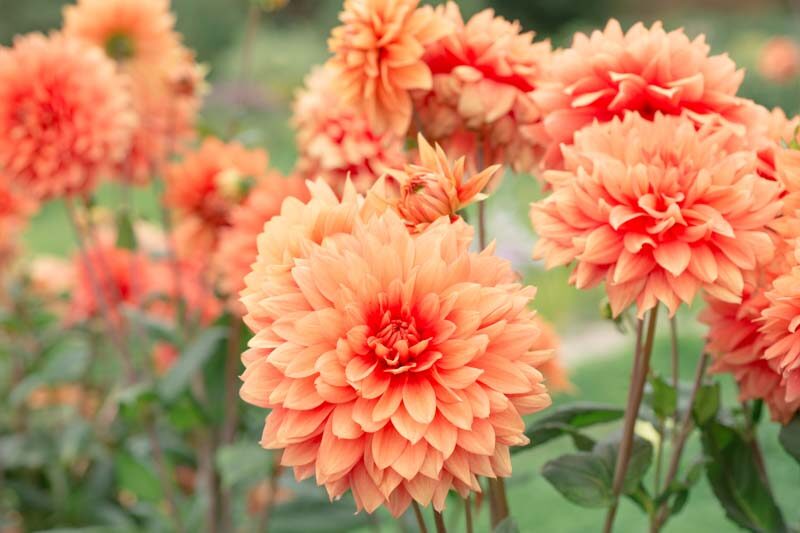Managing Dahlia Pests and Diseases: Essential Strategies against Common Dahlia Problems for Healthy Blooms

Dahlia, a genus of tuberous plants native to Mexico, has captivated gardeners and flower enthusiasts worldwide with its stunning blooms and vibrant colors. Known for their diversity, dahlias range in size from petite bedding varieties to striking dinner-plate-sized wonders, making them a versatile choice for any garden design. Their popularity stems not only from their breathtaking beauty but also from their ability to bloom from midsummer until the first frost, offering a prolonged display of splendor.
While dahlias are relatively easy to grow, their lush foliage and showy flowers can attract various pests and diseases. Like any plant, dahlias have specific environmental and care requirements; when these are not met, they become more susceptible to issues.
Dahlias, with their stunning blooms and lush foliage, are a magnet for various garden pests. These beautiful plants, while resilient, can be susceptible to infestations that threaten their health and vitality. Common pests like aphids, spider mites, slugs, and earwigs are attracted to dahlias, drawn by their vibrant flowers and tender leaves.
Understanding these pest issues is crucial for gardeners, as early detection and effective management are key to maintaining the health and beauty of these spectacular flowering plants in any garden setting.
Description: Aphids are small, pear-shaped insects, often green but sometimes black, yellow, or pink. They have long antennae and two tube-like structures called cornicles protruding from their hind end. They’re notorious for sucking plant sap, causing various issues.
Symptoms: Infested plants exhibit yellowed, curled, or distorted leaves. Aphids leave behind a sticky substance called honeydew, which can lead to sooty mold growth. Stunted growth and reduced yields are also common. In some cases, they transmit plant viruses, causing further damage and irregular patterns on leaves.
Treatment Indoors: Treat aphids on indoor plants by wiping them off with a damp cloth or spraying with a mixture of water and a few drops of mild dish soap. For persistent infestations, apply neem oil or insecticidal soap directly to the affected areas. In most cases, the treatment will have to be repeated multiple times. Imidacloprid granules put onto the soil will also control aphids.
Treatment Outdoors: Blast aphids off outdoor plants with a strong jet of water from a hose. Encourage natural predators like ladybugs, lacewings, damsel bugs, or hoverflies. If necessary, spray affected plants with neem oil or a ready-to-use insecticidal soap, ensuring complete coverage, especially under leaves where aphids congregate.
Description: Earwigs are small, slender insects with pincers on their rear, known for their nocturnal habits. They are commonly found in damp environments and can be both beneficial (eating pests) and harmful (damaging plants).
Symptoms: Earwig damage is marked by irregular holes and chewed margins on plant leaves and soft flower petals. In vegetable gardens, they often target seedlings and soft fruits. Damage often occurs after rainy weather as earwigs seek dry shelter and climb into plants and onto leaves.
Treatments: Control earwigs by reducing moisture around plants, setting up traps (like shallow containers filled with oil), and clearing garden debris. In severe cases, use environmentally friendly insecticides or encourage natural predators like birds and toads in the garden.
Description: Slugs are soft-bodied, legless mollusks commonly found in moist environments. They move by gliding along a trail of mucus, which they secrete. Varying in color, they are often seen after rain, at night, or in damp conditions.
Symptoms: Slug damage includes irregular holes in leaves, flowers, and fruits, with a slimy residue often present. Seedlings and tender plants are particularly vulnerable. The damage is usually more extensive during wet, humid conditions.
Treatments: Control slugs by removing garden debris, using barriers like copper tape, setting beer traps, or applying diatomaceous earth around plants. Hand-picking at night can be effective. In severe cases, environmentally friendly slug pellets can be used, ensuring they are safe for wildlife and pets.
Description: Snails are mollusks with coiled shells on their backs, known for their slow movement and preference for moist environments. Active mainly at night or during wet weather, they feed on a variety of plants and can be problematic in gardens.
Symptoms: Snail damage is evident as irregular, ragged holes in leaves and flowers, often accompanied by a silvery slime trail. Young plants and tender leaves are particularly susceptible, with damage more pronounced in damp, shady areas.
Treatments: Control snails by removing hiding places like debris and stones, setting up beer traps, or using barriers such as copper strips. Hand-picking snails during damp evenings is effective. In severe cases, use environmentally friendly snail baits, ensuring they are safe for other wildlife and pets.
Description: Leafhoppers are small, slender insects measuring around 1/8 to 1/2 inch in length. They possess wedge-shaped bodies, often green, yellow, or brown, allowing them to blend in with the foliage. These agile insects are known for their ability to jump long distances when disturbed.
Symptoms: Infestations of leafhoppers can lead to a condition known as “hopperburn,” where leaves display discoloration, curling, and necrotic spots. The insects feed on plant sap, causing a reduction in the plant’s overall vigor and potentially leading to stunted growth and reduced crop yields.
Treatments: Managing leafhopper populations involves a combination of cultural, biological, and chemical strategies. Encouraging natural predators like ladybugs and lacewings, can help control their numbers. Insecticidal soaps or neem oil can be effective against nymphs. For severe infestations, appropriate insecticides might be considered, following label instructions and environmental guidelines.
Description: Thrips are tiny, slender insects with fringed wings, known for their sap-sucking behavior. They are often found on flowers and leaves, causing damage as they feed. Thrips can be various colors, including black, brown, or yellow, and are typically only a few millimeters long.
Symptoms: Thrips feeding results in stippled, distorted, or silvery leaves and flowers, often accompanied by black fecal spots. Blossoms may be deformed or discolored, and severe infestations can stunt plant growth or reduce yields in vegetable gardens.
Treatment Indoors: Begin by rinsing leaves with water to remove thrips physically. Follow up by spraying the plant with insecticidal soap, ensuring thorough coverage of all leaf surfaces. For plants with flower buds harboring thrips, use a systemic insecticide like spinosad, acetamiprid, or imidacloprid to reach those hidden within. Sticky traps can catch flying adults. Repeat treatments weekly until thrips are eliminated, isolating affected plants to prevent spread.
Treatment Outdoors: Spray outdoor plant foliage with insecticides effective against thrips, such as spinosad, acetamiprid, imidacloprid, cyfluthrin, deltamethrin, or lambda-cyhalothrin. Ensure complete coverage, focusing on flower buds for systemic control. Applying imidacloprid granules to the soil can also provide effective, long-lasting protection. Encourage natural predators like lacewings and ladybugs.
Description: Tarnished Plant Bugs are small, oval-shaped insects, mottled brown and green, known for their quick movements. They feed on a wide range of plants, sucking sap and causing damage. Adults are about 1/4 inch long, with nymphs appearing yellow-green and wingless.
Symptoms: Damage includes distorted and stunted growth of shoots and buds, with speckled or deformed flowers and leaves. Tarnished Plant Bugs inject a toxin while feeding, leading to a condition known as “cat-facing” on fruits.
Treatments: Management involves regular garden cleanup to remove debris and weeds, which are breeding grounds. Use row covers to protect plants or trap crops. Encourage natural predators such as damsel bugs and lacewings. For severe infestations, consider using suitable insecticides following label instructions carefully.
Description: Spider mites are minuscule spider-like pests notorious for damaging plants by feeding on the sap within the leaves and stems. They thrive in hot, dry conditions and can multiply rapidly, often creating fine webs on infested plants, similar to spiders.
Symptoms: Affected plants exhibit yellow, stippled leaves from the mites’ feeding, progressing to bronze or reddish discoloration with heavy infestation. Webbing is a definitive sign, and severe cases can lead to leaf loss, stunted growth, and plant death, especially when left unchecked.
Treatment Indoors: Increase humidity to deter spider mites in indoor plants. For sturdy plants, forcefully spray with water, especially under leaves, to remove mites and webs. Apply insecticidal soap or neem oil for stubborn cases, ensuring full coverage. Repeat weekly until the infestation is under control.
Treatment Outdoors: Forcefully spray outdoor plants with water to dislodge spider mites and disrupt their webs. Treat with insecticidal soap, neem oil, or a sulfur-based insecticide covering all leaf surfaces for persistent issues. Weekly treatments may be necessary for several weeks to manage mite populations effectively. Introducing or encouraging natural predators like ladybugs and lacewings can also help control mite populations.
Description: Caterpillars are the larval stage of butterflies and moths, characterized by their elongated, segmented bodies and voracious appetite. They possess a pair of antennae, strong mandibles for chewing leaves, and several pairs of legs that aid in movement.
Symptoms of Infestation: Signs of caterpillar infestation include visible chewed leaves, skeletonized foliage, silk threads, and frass (caterpillar droppings) on or around the affected plants. Severe infestations can lead to stunted plant growth, reduced crop yields, and, in extreme cases, complete defoliation.
Treatments: Control measures depend on the severity of the infestation and the caterpillar species. Options include manual removal for small infestations, encouraging natural predators (birds, assassin bugs, lacewings, predaceous ground beetles, and spiders), and Bacillus thuringiensis (Bt) that produces toxins harmful to caterpillars when ingested. Insecticides should be used cautiously to avoid harming beneficial insects.
Dahlias are not immune to various diseases that can mar their beauty. These floral wonders can fall prey to a range of fungal, bacterial, and viral infections, commonly manifested as wilting, discoloration, and deformities.
Recognizing and addressing these disease issues is vital for gardeners, as healthy dahlias are not only more resistant to pests but also more capable of producing the spectacular, vibrant flowers that make them such a cherished addition to gardens and floral arrangements.
Description: Powdery mildew is a common fungal disease affecting a wide range of plants. It manifests as white or grayish powdery spots, primarily on the upper surfaces of leaves and stems. Though it can mar a plant’s appearance, it’s often more of a cosmetic issue than a fatal one.
Symptoms: Powdery white or grayish-white fungal growth on the leaves, stems, and sometimes fruit and flowers. Distorted or stunted growth, yellowing or curling of leaves, stunted or reduced fruit or flower production, reduced plant vigor.
Treatments: Increase air circulation, reduce overhead watering, and prune affected areas. Apply fungicides or homemade solutions like baking soda sprays. Neem oil and horticultural oils can also suppress the spread. Ensure good garden hygiene to prevent recurrence.
Description: Verticillium wilt is a soil-borne fungal disease affecting a wide range of plants. It invades the roots, spreading through the plant’s vascular system, hindering water and nutrient transport. The fungi responsible, primarily Verticillium dahliae, can persist in the soil for years, making management challenging.
Symptoms: Infected plants exhibit wilted, yellowing, and stunted leaves, often on one side of the plant or a single branch. Vascular discoloration may be visible when stems are cut open. Over time, the affected parts may die back, and the plant’s overall health and productivity are significantly reduced.
Treatments: There is no cure for Verticillium wilt; management focuses on prevention and mitigation. Planting resistant varieties, improving soil drainage, and practicing crop rotation can reduce the risk of infection. Infected plant material should be removed and destroyed, not composted. Soil fumigation might be considered for high-value crops, following environmental guidelines and recommendations from agricultural extensions.
Description: Gray Mold, caused by the fungus Botrytis cinerea, is a common plant disease affecting a wide range of plants. It thrives in cool, humid conditions and can quickly spread, causing significant damage to flowers, fruits, and foliage.
Symptoms: Symptoms include grayish-brown fuzzy mold on flowers, leaves, and stems, often starting at wounded or senescent areas. Infected flowers may rot, leaves can develop necrotic spots, and in severe cases, the whole plant may wilt and die.
Treatments: To control Gray Mold, improve air circulation, reduce humidity, and avoid overhead watering. Remove and destroy infected plant parts promptly. In preventive measures, apply fungicides specifically labeled for Botrytis, particularly during periods of high humidity or when the weather forecast predicts cool, wet conditions. Regularly clean up plant debris to minimize fungal spores.
Description: Aster Yellows is a disease caused by a phytoplasma, a type of bacteria-like organism. It affects a wide range of plants, including asters, dahlias, and various vegetables. Transmitted by leafhoppers, it disrupts normal plant growth, leading to stunted and distorted development.
Symptoms: Symptoms include yellowing of leaves, stunted growth, and the production of abnormal, often greenish, flower structures. Infected plants may exhibit a “witches’ broom” appearance due to the proliferation of shoots. Flowers may fail to develop proper coloration or form.
Treatments: There is no cure for Aster Yellows. Management focuses on prevention and control. Remove and destroy infected plants to prevent spread. Control leafhopper populations through insecticide application or natural predators. Monitor plants regularly for symptoms, especially in areas where leafhoppers are prevalent. Maintain garden hygiene and weed control to reduce habitats for leafhoppers.
Description: Mosaic Virus is a group of viruses affecting a wide range of plants, causing mottled leaf discoloration. It’s transmitted by pests or through infected plant material. The virus disrupts normal cell growth, leading to the distinctive mosaic pattern on leaves.
Symptoms: Symptoms include a mosaic-like pattern of light and dark green on leaves, stunted plant growth, and distorted leaf shapes. In some cases, flowers may be discolored or malformed. Infected plants often exhibit reduced vigor and yield.
Treatments: There is no cure for Mosaic Virus once a plant is infected. Management focuses on prevention: use virus-free planting material, control pest vectors like aphids and thrips, and remove and destroy infected plants immediately. Practice good sanitation by cleaning tools and hands after handling infected plants. Avoiding mechanical transmission through pruning or other activities is also crucial.
Abiotic problems in dahlias refer to issues caused by non-living factors such as environmental stresses, cultural mismanagement, or physical damage rather than pests or diseases.
| Cause | Symptom | Treatment |
| Water Stress | Overwatering leads to yellowing leaves, root rot, and a wilted appearance. Underwatering causes drooping, dry leaves, and stunted growth. | Ensure proper drainage and water only when the top inch of soil is dry. Establish a consistent watering schedule, ensuring deep watering reaches the roots. |
| Nutrient Deficiencies | Yellowing leaves (nitrogen deficiency), purple-tinged leaves (phosphorus deficiency), or brown leaf edges (potassium deficiency). | Apply a balanced, slow-release fertilizer and ensure the soil is rich in organic matter. Regular soil testing can help identify specific nutrient needs. |
Sunlight Issues |
Leggy growth and sparse blooming in too much shade; leaf scorch or fading in excessive sun. | Relocate dahlias receiving inadequate sunlight to a sunnier spot. For those in too much sun, provide some afternoon shade, especially in hotter climates. |
Temperature Stress |
Wilted or burned leaves in high heat; blackened or soggy foliage after frost. | Provide mulch to regulate soil temperature, use shade cloth during extreme heat, and ensure dahlias are planted after the last frost date. In fall, lift tubers before the first frost in cold climates. |
Soil Conditions |
Poor growth, yellowing leaves, and root diseases in waterlogged soil; stunted growth in compacted soil. | Amend soil with organic matter to improve drainage and aeration. Avoid planting in areas prone to waterlogging. |
Chemical Damage |
Distorted, curled, or scorched leaves; sudden plant decline. |
Avoid spraying herbicides near dahlias and use pesticides/fertilizers as per instructions. If damage occurs, flush the soil with water to dilute chemicals. |
Mechanical Damage |
Broken stems, damaged foliage, or uprooted plants. | Protect plants from foot traffic and animals. Prune damaged areas to encourage new growth. |
Regular monitoring, proper cultural practices, and creating an optimal growing environment are key to preventing and treating abiotic problems in dahlias.
What is the common disease on dahlias?
The most common disease affecting dahlias is Powdery Mildew, which appears as a white, powdery coating on leaves and stems. Other prevalent issues include Botrytis Blight (Gray Mold), characterized by brown, rotting spots on flowers and leaves, and Viral Diseases like Dahlia Mosaic Virus, which causes mottling and distortion of leaves.
What does an overwatered dahlia look like?
n overwatered dahlia typically shows signs like yellowing or browning of leaves, wilting, and a general soggy or limp appearance. The leaves may droop despite the wet soil, and in severe cases, root rot can develop, causing the plant to collapse.
Why are my dahlias struggling?
Dahlias may struggle due to several factors: improper watering (either too much or too little), poor soil drainage, inadequate sunlight, nutrient deficiencies, or pest and disease infestations. Ensuring the right growing conditions and regular monitoring for pests and diseases are crucial for healthy dahlia growth.
Why are my dahlias suddenly dying
Sudden death in dahlias can be caused by severe root rot due to overwatering or waterlogged soil, extreme temperature fluctuations, or a rapid onset of a disease like Botrytis Blight or a viral infection. It’s essential to examine the plant for signs of these issues and consider recent care routines and environmental conditions for clues.
Here’s a list of 40 famous dahlia varieties, noted for their unique beauty, color, form, and popularity among gardeners and floral enthusiasts
Learn how to plant, grow and care for Dahlia flowers and add a bright pop of summer color to your garden
The flowers of Dinner Plate Dahlias make quite an impression! They are unbelievably large – up to 12 in. across (30 cm) – and will bloom continuously from July until the first touch of frost
These unusual dahlia varieties are really worth mentioning and should not be overlooked by the gardener. Why? Because these beauties offer masses of stunning flower colors that contrast strikingly with their deep mahogany-to-black foliage. Effect in the garden guaranteed! Here is the roster of these most popular beauties.
Decorative Dahlias are a stunning group within the Dahlia genus, known for their large, lush blooms that make a grand statement in any garden or floral arrangement. These dahlias are characterized by their broad, flat petals, often arranged in a symmetrical pattern. Ranging in size from smaller varieties to the large, dinner-plate types, they are a favorite among gardeners for their striking appearance and diverse color palette.
Pompon and Ball Dahlias feature relatively small, fully double, globe-shaped flowers with petals blunt or slightly rounded at their tips. How not to marvel at the perfect petal arrangement of these dahlias? They display an infinite swirl of florets with fold upon fold of incredibly flawless petals.
Dahlias are versatile and stunning flowers that come in a wide variety of colors, shapes, and sizes. They are beloved for their intricate blooms, ranging from single to fully double forms. With their vibrant hues and diverse petal arrangements, dahlias make excellent cut flowers and add a vibrant touch to gardens and floral arrangements alike.


















Create a membership account to save your garden designs and to view them on any device.
Becoming a contributing member of Gardenia is easy and can be done in just a few minutes. If you provide us with your name, email address and the payment of a modest $25 annual membership fee, you will become a full member, enabling you to design and save up to 25 of your garden design ideas.
Join now and start creating your dream garden!
Create a membership account to save your garden designs and to view them on any device.
Becoming a contributing member of Gardenia is easy and can be done in just a few minutes. If you provide us with your name, email address and the payment of a modest $25 annual membership fee, you will become a full member, enabling you to design and save up to 25 of your garden design ideas.
Join now and start creating your dream garden!